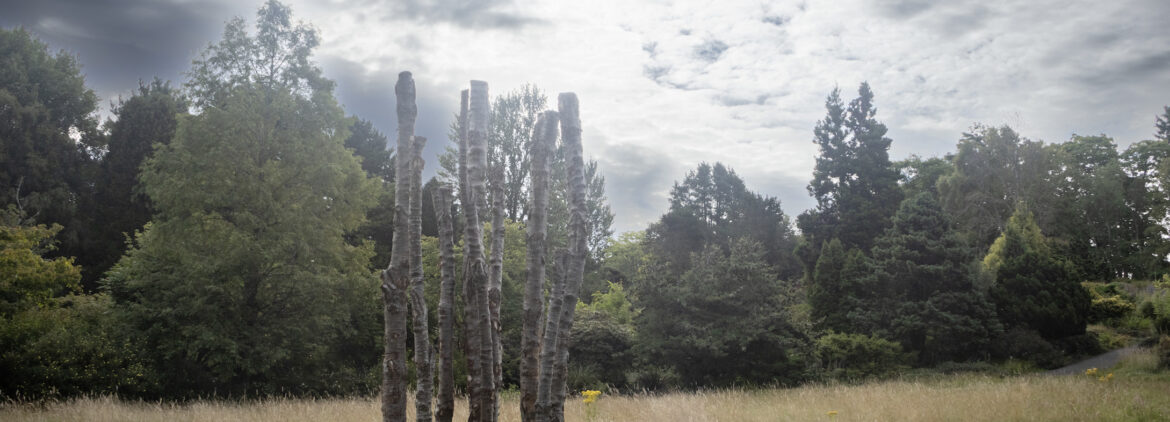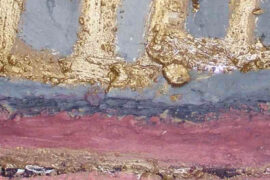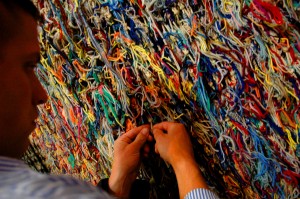I want to begin by expressing my gratitude for the opportunity Transpositions is graciously affording myself and others to reflect on Gathering Surface, the recent land art installation from my friend and colleague Dan Drage, viewable at the St. Andrews Botanical Gardens through early February of 2024. I will be particularly pleased if this collection of responses serves, in some small way, to broaden the reach of this exceptional work. While I hope that this brief reflection—alongside those of my fellow commentators—will succeed in articulating something of what makes Drage’s art especially worthy of note, I am confident that the offering of all our words combined cannot begin to exhaust what the Pit-and-Mounds, Clusters, and the Sleeping Fir of Gathering Surface have to offer in personal encounter. As his comments reveal, these are pieces born of an artistic process that constitutes a form of ongoing contemplation, and they invite the same from their viewers. If you happen to be in the area, please take the opportunity to go to the Botanical Gardens and see these works for yourself; perhaps even take up their generous invitation to your own ponderings.
For my part, the installation continues to prompt reflection on a distinctly theological conviction, the wrestling with which resides very near the heart of their genesis. This conviction, expressed succinctly by Drage in his remarks at the show’s opening in June of this year, is that he views ‘the world as given, as a gift—not as something […] to own, but rather as something to cherish, as something towards which to wonder’.2 This belief provides, I think, one particularly clarifying lens through which to approach Drage’s works on display here. In what follows, I will offer some brief thoughts on the theological implications of this belief in the givenness of all that is, attempting to highlight how these pieces reflect this conviction in various, nuanced ways. Further, I will underscore their potential to summon the viewer into a personal and parallel wrestling with how one might view the world—and their place in it—differently were they to receive it as agift.
The Gift Received
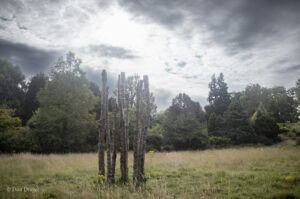 Understanding the world as given is a distinctly theological conviction embedded in the Christian tradition, though not entirely unique to it. Identifying the centrality of this theme to his work, Drage also notes that this is a belief shared in some regard by ‘many indigenous cultures and most religions’.2 One could presumably agree to an idea of the world as [a] given (a fact, a thing with intelligible existence) with no religious or theological connotations implied. Nevertheless, to understand the world as given, as a gift, is perhaps the fundamental implication of the Christian doctrine of creation ex nihilo. To confess that the God who is from eternity entirely whole—lacking in nothing, living in perfection and beatitude as a triune community of love, utterly without need of anything outside of God-self—creates all that exists from nothing with the simple intent ‘to share the blessings of existence outside of God’s own life’3 is to understand the whole created order, ourselves included, as absolute gratuity, as divine generosity bodied forth as world. Gathering Surface attests that if this is true, then ‘you and I must also be gift’.4 As human, we are not somehow separate from or above the world but a part of its giftedness, created to share in the blessing of our creator. As the Catholic philosopher William Desmond puts it, we are
Understanding the world as given is a distinctly theological conviction embedded in the Christian tradition, though not entirely unique to it. Identifying the centrality of this theme to his work, Drage also notes that this is a belief shared in some regard by ‘many indigenous cultures and most religions’.2 One could presumably agree to an idea of the world as [a] given (a fact, a thing with intelligible existence) with no religious or theological connotations implied. Nevertheless, to understand the world as given, as a gift, is perhaps the fundamental implication of the Christian doctrine of creation ex nihilo. To confess that the God who is from eternity entirely whole—lacking in nothing, living in perfection and beatitude as a triune community of love, utterly without need of anything outside of God-self—creates all that exists from nothing with the simple intent ‘to share the blessings of existence outside of God’s own life’3 is to understand the whole created order, ourselves included, as absolute gratuity, as divine generosity bodied forth as world. Gathering Surface attests that if this is true, then ‘you and I must also be gift’.4 As human, we are not somehow separate from or above the world but a part of its giftedness, created to share in the blessing of our creator. As the Catholic philosopher William Desmond puts it, we are
creatures of an absolute source that gives us to be and gives us to be as good. […] We are only self-defining because we [are] originally given to be as selves, and as selving; only creative because created; only courageous because encouraged; only loving because already loved and shown to be worthy of love; only become good to the degree that we are grateful for a good we do not ourselves produce; only become truthful because there is a truth more original than ourselves that endows us with the power to seek truth and the confidence that should we search truly we will find that truth.5
We are, he maintains, ‘endowed. We are endowments. There are enabling powers, re-sources, first given before they can be invested in something further’.6
To accept this as reality is to receive the world and ourselves as a gift, sharing in the generative powers of the absolute source. It should transform the whole of our way of being in the world, manifest in the creative expression of our living and making—the poesis of our lives. As endowments, recipients of enabling powers and re-sources, we are further invested with the promise of fruitfulness, as Desmond suggests in citing the parable of the talents (Matthew 25:14-30, Luke 19:11-27).7 In this empowered freedom, we are loosed, as Richard Kearney notes, for ‘re-creation of a prior creation, a creative mimesis expressing a second yes in response to the primary yes of divine genesis—an act we experience existentially as call and gift’.8 When received as such, the divine generosity manifest in creation begets a generous return from God’s created image bearers. Gathering Surface is, in my estimation, precisely this: a re-creation born in response to personal gifting and a call that intends to wake the viewer up to their own giftedness that they might respond in turn.
Turning to the individual pieces that make up Gathering Surface, how might we see them through the lens of this existential “call and gift” in which we participate? How might these works invite us to receive the gift of participation in the world and heed the call consequent to our receiving? Since art, for me, should be measured by the degree to which it allows for a capacious dwelling with the questions of life, rather than by any definitive answers it may or may not provide, my reflections here cannot hope to be comprehensive. Instead, what I offer means only to suggest entry points for further reflection—my own every bit as much as yours.
Pit-and-Mound Pairs
The Pit-and-Mound pairs recur at different points in the Gardens. They are, as one might assume, simple pairings of a pit dug into the ground with a mound directly alongside made up of the sod removed to form the pit. The pits are each only a few inches deep, yet still large enough for a person to lie down in—which is encouraged. According to the artist, their locations were chosen, at least in part, for the view that each spot affords to the viewer game enough to accept this implicit invitation issued by the pits.
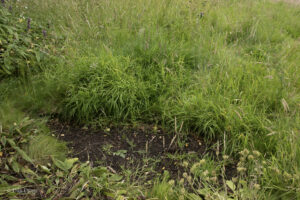 These pairs summon the viewer to a change in vantage point, and it is one of their great strengths—and a mark of the artistic generosity of their maker—that they do so without any premature foreclosure on what the viewer “should” take away from such an experience. Nevertheless, it is significant that to lie within one of the elliptical-, gothic arch-, or mandorla-shaped pits,9 or to sit upon the corresponding mound, requires one to get low, close to the ground, bidding a reorientation to that which we often take for granted as “environment,” while also giving an upward view towards the sky. For me, the experience of being in/on/with these pairs calls to mind the familiar line of the liturgy for Ash Wednesday, ‘Remember, O Man… Remember, O Woman, you are but dust, and to dust you shall return.’ Like this liturgical charge, Pit-and-Mound asks one to remember their origin and end, not simply in terms of the mortal life and death of the body, but also of archē and telos—the enabling source of our being and the ultimate goal or purpose towards which our human existence is directed. If we are born of dust of the earth and breathe of God, and when we expire our final breath, it is to that self-same dust we return, then the second birth of our eternal glorification—evocatively described by John the Revelator as the advent of a new heaven and a new earth—must also be intimately bound up with the glorification of this earth and this heaven. In this remembrance also lies the possibility of a re-membering, a call to belonging in the community of the whole created order, to consider anew what it might mean to accept, in the most wholistic possible sense, the truth that the Desert Father Abba Anthony put so succinctly: ‘Our life and our death is with our neighbour’.10
These pairs summon the viewer to a change in vantage point, and it is one of their great strengths—and a mark of the artistic generosity of their maker—that they do so without any premature foreclosure on what the viewer “should” take away from such an experience. Nevertheless, it is significant that to lie within one of the elliptical-, gothic arch-, or mandorla-shaped pits,9 or to sit upon the corresponding mound, requires one to get low, close to the ground, bidding a reorientation to that which we often take for granted as “environment,” while also giving an upward view towards the sky. For me, the experience of being in/on/with these pairs calls to mind the familiar line of the liturgy for Ash Wednesday, ‘Remember, O Man… Remember, O Woman, you are but dust, and to dust you shall return.’ Like this liturgical charge, Pit-and-Mound asks one to remember their origin and end, not simply in terms of the mortal life and death of the body, but also of archē and telos—the enabling source of our being and the ultimate goal or purpose towards which our human existence is directed. If we are born of dust of the earth and breathe of God, and when we expire our final breath, it is to that self-same dust we return, then the second birth of our eternal glorification—evocatively described by John the Revelator as the advent of a new heaven and a new earth—must also be intimately bound up with the glorification of this earth and this heaven. In this remembrance also lies the possibility of a re-membering, a call to belonging in the community of the whole created order, to consider anew what it might mean to accept, in the most wholistic possible sense, the truth that the Desert Father Abba Anthony put so succinctly: ‘Our life and our death is with our neighbour’.10
Clusters
If Pit-and-Mound invites a reorientation to the ground and sky, then the Clusters expands the field of our transformed vision, directing it to the space between. This space between is the space of our habitation, the space in which we live and move. This space is neither earth nor heavens, but as the gap between them, it acts as a porous boundary and space of life that depends on its relation to both. Fittingly, the wood that provides the primary material of each cluster (composed of charred planks used to stretch canvases, partially squared rhododendron branches, or the trunks of beech trees felled by a storm) is sunk deep into the ground but reaches upward to the sky, binding together—or, perhaps better, coinhering—earth and heavens.
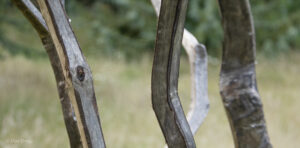 As fellow inhabitants of this liminal space, might we also be sites of this coinherence of heaven and earth? As Drage led us through the garden at the opening in June, we encountered the clusters in a sequence that seemed to walk us backwards: from the charred spruce planks to the partially hand-squared but still-recognizable rhododendron branches, to the stately beech trunks, largely unaltered beyond the cut at the exposed end of each. Encountering the clusters in this order meant that at each stage, the amount of human interference in the physical shaping of the wood was less, suggesting a sort of retrieval of a kind of artistic being-with the natural world. Such a retrieval does not forego the human impulse to create from the stuff of earth but looks to move with the grain of the material. It is a cooperation between artist and material, rather than a manipulation of material for the artist’s own ends. Artist and material, in some sense, become co-creators, each contributing differently but together, towards making visible this space of meeting and mingling—earth and heaven, ground and sky, material and spirit, the sacred and the everyday.
As fellow inhabitants of this liminal space, might we also be sites of this coinherence of heaven and earth? As Drage led us through the garden at the opening in June, we encountered the clusters in a sequence that seemed to walk us backwards: from the charred spruce planks to the partially hand-squared but still-recognizable rhododendron branches, to the stately beech trunks, largely unaltered beyond the cut at the exposed end of each. Encountering the clusters in this order meant that at each stage, the amount of human interference in the physical shaping of the wood was less, suggesting a sort of retrieval of a kind of artistic being-with the natural world. Such a retrieval does not forego the human impulse to create from the stuff of earth but looks to move with the grain of the material. It is a cooperation between artist and material, rather than a manipulation of material for the artist’s own ends. Artist and material, in some sense, become co-creators, each contributing differently but together, towards making visible this space of meeting and mingling—earth and heaven, ground and sky, material and spirit, the sacred and the everyday.
‘The materials teach me’, Drage said in June. The gift received becomes the gift given.
Sleeping Fir
I want to close on what has become perhaps my favourite piece of the whole exhibition. On a surface level, Sleeping Fir is Gathering Surface’s least visually remarkable work. Yet, in my view, it testifies most profoundly of all the pieces to the inherent creativity permeating the world as given. One of the challenges to arise alongside a great many blessings of modern science is the mistaken impression that understanding the “how” of a particular phenomenon is somehow to explain away the mystery that remains—often obscured—in an unspoken but primal “why”. Like Jesus’ parable of the grain of wheat in John 12, the power of Sleeping Fir lies in the way it re-mystifies a process most of us learned about in our primary school science classes under the name “The Life Cycle”, awakening us to an originary and sacred paradox contained therein that ultimately transcends our best conceptualizations.
By setting apart and giving a new name to the natural cycle wherein the organic material of a fallen fir tree returns to the earth and breaks down, vivifying the soil and giving rise to new life, Drage’s creative gift is most apparent in its humility. By highlighting the artistry already at work in the world—indeed, as nothing less than the animating force behind his own work—Drage effects an annunciation of the enduring nature of the gift as endlessly given, received and given again. Sleeping Fir invites us to attend to something that is always already happening around us all the time, to which we are often oblivious. In so doing, it transfigures a buried log into a burning bush from which we may hear a voice call out: ‘The ground upon which you stand is holy. Will you take off your shoes?’

